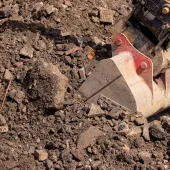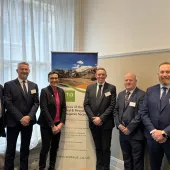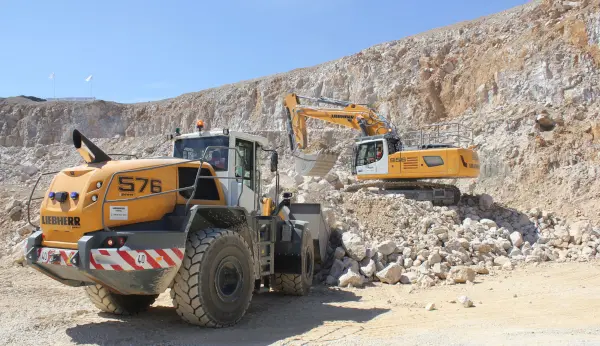Beyond the landfill debate: A blueprint for circular Britain
Hannah Haeffner, innovation and sustainability director with Booth Group, calls for greater engagement on landfill tax reform
OVER the past few weeks, I have seen a wave of articles surrounding the UK Government’s Landfill Tax consultation. Many of them are well intentioned, but far too many miss the mark when it comes to the broader implications of what is at stake. In their rush to respond, they risk painting a simplistic picture of an incredibly complex system.
The true nature of circular economy
Sustainability and circular economy principles are far more intricate than simply diverting waste from landfill. At their core, sustainability involves balancing environmental protection, social well-being, and long-term economic viability. The circular economy sits within this framework as a practical mechanism to deliver that balance by keeping materials in use for as long as possible, regenerating natural systems, and designing out waste.
Minerals, including soils, are fundamental to this system. Once extracted or excavated, they can be reused across multiple construction lifecycles, particularly when their original form and properties are preserved. When responsibly managed, they support not just development, but environmental enhancement, restoring land, supporting habitats, and fulfilling planning obligations. Mineral extraction is, by definition, a temporary land use. Its long-term environmental value lies in how sites are restored and repurposed for biodiversity net gain, development platforms, and landscape regeneration.
Yet current policy proposals risk penalizing this process rather than enabling it. True circularity means understanding that sometimes the highest value of a material lies not in its reprocessing, but in its reuse close to origin, in development platforms, in restoring ecological function, and in enabling future land use.
The resource scarcity challenge
We are already entering a period of increasing resource scarcity, and access to vital materials is tightening through a combination of overregulation, permitting delays, and financial constraints on restoration. These materials are not optional, they are essential to constructing the roads, homes, schools, and hospitals that society relies on. If we are serious about delivering 1.5 million new homes, the UK will need at least 300 million tonnes of aggregates, and that is without accounting for the additional clays, sands, and secondary materials required.
There is a growing and deeply concerning disconnect in the wider built environment sector when it comes to the role that restoration plays in enabling continued mineral extraction. Without the ability to restore worked-out phases of a quarry, many sites are legally restricted from progressing further due to planning conditions that limit open phases or tie ongoing extraction to the completion of restoration. This sits at the core of the UK’s capacity to provide the raw materials that national development depends on.
Economic and environmental contradictions
The consequences of failing to secure these resources go beyond supply chain disruption. If we strangle construction, development and mineral extraction at the source, we are not just delaying houses and infrastructure, we are stalling economic recovery. The UK urgently needs growth, employment and large-scale productivity drivers that can support social mobility and regional regeneration.
The current policy direction risks creating a deeply counterproductive outcome: making greenfield development more financially viable than brownfield. Brownfield sites are already burdened with complexity, including legacy contamination, costly remediation, and more demanding planning processes. They are exactly the kind of locations that sustainable development should prioritize, recycling land, protecting green spaces, and restoring degraded environments.
Yet the proposed landfill tax reform piles additional costs and regulatory hurdles on these projects, tipping the balance in favour of building on undeveloped, ecologically sensitive land. If developers are financially and practically nudged toward greenfield because brownfield becomes unworkable, then the policy has failed not only in economic terms, but on environmental grounds too.
The hidden costs and limited awareness
Despite being central to the future of the built environment, many stakeholders in planning, housing, infrastructure, and development remain unaware of the reform’s scope and implications. Estimates suggest it could add between £8,000 and £12,000 to the cost of every new home, yet the issue remains largely under the radar.
The problem is not just the complexity of the reform, it is the narrow narrative being used to promote it. Landfill is being painted as inherently bad, without recognizing the essential role that soils play in sustainable development strategies. This is not a niche concern for the quarrying industry. These reforms will ripple through every corner of the built environment, from developers and civil engineers to local authorities and housing providers.
Regulatory challenges and unintended consequences
The regulatory unpredictability we are already experiencing is impacting business confidence and economic stability. Investors and operators are being asked to commit to long-term infrastructure and environmental goals in a system that keeps shifting the rules. Recovery permits, which once took months to obtain, are now taking years due to under-resourced regulators and policy shifts creating bottlenecks throughout the system.
Many quarries still operate under landfill permits, not out of environmental preference but as a practical response to regulatory constraints; you cannot dual track recovery and planning applications, but you can run landfill and planning in parallel. Some of these sites are operating on 20-year time frames. Expecting them to change permitting under a policy window of just a few years, if there was even an option to do this, is entirely unworkable.
Stricter regulation without effective enforcement only fuels illegal waste activity. When it becomes easier to dump waste illegally than to comply with the rules, criminal elements will fill the void, leaving local councils and landowners to clean up the mess, both literally and financially.
The classification problem
At the heart of the issue lies the question of how we define waste. Much of what is currently labelled as such, particularly soils and inert construction materials, should be treated as by-products or even resources. But under current regulations, the incentive is to classify them as waste due to a fundamental lack of understanding of their value and potential. The broader policy framework appears to be an exercise purely in tax collection rather than genuine environmental improvement. This is not only counterproductive but actively undermines the principles of reuse and recovery that the government claims to support.
The lack of clarity around material classification and taxation creates confusion for producers and developers alike, making noncompliance more likely, not out of malice, but because the framework itself is so poorly defined. Questions have also been raised about the sustainability of low-value material reuse. Many of these materials are not inherently problematic, they are just harder and more expensive to process. Penalizing their reuse, when the technology to repurpose them is still developing, risks shutting down potential innovation.
From both a financial and carbon perspective, the most sustainable solution is often the one that involves doing less. If we are serious about net-zero targets and responsible land development, then reusing soils and clays in their current form to restore quarries and produce stable development platforms should be seen as a high-value outcome.
A better path forward
There will inevitably be winners and losers in any policy shift, but what is unfolding here risks throwing the baby out with the bathwater. The proposed changes go far beyond targeting problematic waste types or rogue operators, they threaten to penalize entire sectors that have spent years developing responsible, compliant solutions. Misclassification of trommel fines and the misuse of waste codes are real issues that must be addressed, but they require better regulation and clearer definitions, not blanket penalties.
Why was the lower rate of landfill tax introduced in the first place? It was designed to reflect the low risk posed by high-volume, non-hazardous materials, which offer significant environmental benefits when reused properly. Instead of lumping all material streams together, we should be focusing our efforts on the real problem areas and ensuring those are regulated effectively.
Above all, we must preserve the exemptions for quarry restoration. These sites remain a vital part of bringing land back into beneficial use for the UK. Any implementation must be paced, especially considering the timescales and backlogs the Environment Agency is already dealing with. Let us get permitting reform right, engage stakeholders meaningfully, and design policies that reward compliance rather than punish it.
This consultation could be a turning point for the waste, construction, and land restoration sectors, but only if we take the time to understand its full implications, engage constructively, and push back against short-term thinking. Otherwise, we risk doing lasting damage not just to the environment, but to the economy, the workforce, and the very communities that are counting on a more resilient and opportunity-filled future for the UK.

1. What impact will the proposed landfill tax reforms have on how construction sites manage and dispose of excavated soil?
The proposed landfill tax reforms will significantly disrupt how waste soils are managed, with multiple negative consequences:
Higher costs: Skip hire costs for householders are expected to rise by 34–36%, and the cost per new home could increase by £8,000–£12,000. These costs will pressure developers and local authorities, particularly on constrained brownfield sites.
Increased misclassification of soils: Developers may be forced to classify more excavated soils as ‘waste’ due to regulatory uncertainty and tax exposure – even where soils are clean and suitable for reuse.
Permitting delays: The Environment Agency has consistently rejected recovery permits, particularly over aquifers and limestone sites, despite reporting an eight-month timeline to HMRC. Actual permitting often takes years.
Loss of restoration capacity: Quarry operators need to restore worked-out phases to comply with planning conditions. Without disposal routes, mineral resources are being sterilized, threatening raw material supply for housing and infrastructure.
Regulatory inconsistency and confusion: The lack of a clear approach to what constitutes waste vs resource will create compliance risks and operational inefficiencies.
2. Will the changes to landfill tax help reduce how much excess soil and material is generated during construction projects?
No. The reforms are not designed to reduce waste generation and offer no mechanisms to support this outcome. In fact:
There are no provisions for incentivising design-stage waste minimization or material efficiency.
Taxation alone does not lead to reduction – it may push materials into landfill due to confusion or permit delays, or result in non-compliance through stockpiling or illegal activity.
The approach appears focused on revenue collection, not sustainable construction practices or design innovation.
3. How might the reforms affect the way projects are planned and procured? Will soil and waste management need to be considered earlier in the process?
Yes, but this change will be driven by risk mitigation rather than sustainability:
Developers and contractors will need to factor in waste classification, permit risks, and disposal costs from the outset.
Procurement strategies will be shaped by the need to avoid financial and regulatory pitfalls, possibly leading to more conservative designs that avoid soil movement altogether.
Brownfield schemes may be excluded from consideration if soils cannot be managed affordably and predictably.
The increased risk profile could lead to fewer bidders or inflated pricing to offset unknowns.
4. Could the landfill tax changes discourage investment in brownfield redevelopment compared with greenfield alternatives?
Yes, unequivocally. The proposed changes create strong disincentives for brownfield reuse:
Brownfield sites already carry higher costs for contamination, remediation, and complex planning. The reforms add disposal and tax costs, making greenfield alternatives more attractive.
If reuse of surplus soils is penalized or blocked due to lack of permits, the economic case for regeneration collapses.
This undermines national objectives including levelling-up, urban densification, and climate targets.
Low awareness among housing and infrastructure stakeholders suggests the reforms were developed without proper sector engagement.
5. Are the reforms likely to lead to more sustainable approaches to waste – such as greater reuse and on-site treatment – or could they have the opposite effect?
Not as currently proposed:
The reforms risk shutting down low-carbon reuse options such as direct application of soils and clays for quarry restoration or development platforms.
Innovation will be stifled if operators fear regulatory uncertainty, rejection of permits, or disproportionate tax liabilities.
Enforcement capacity is not increasing in parallel with regulation, raising the risk of fly-tipping and illegal activity.
There is no funding or policy mechanism to support development of new infrastructure such as ‘soil hospitals’ or on-site treatment hubs.
6. What steps could the Government take to make the landfill tax reforms more balanced, practical, and supportive of sustainable development goals?
The reforms could be improved by implementing the following measures:
Engagement and evidence.
Conduct and publish a formal impact assessment.
Facilitate meaningful collaboration with industry, including trade bodies and developers.
Include a second consultation round with workshops and technical discussions.
Permitting and classification.
Fix the recovery permit process and dual-tracking issue.
Develop hybrid recovery permits that balance compliance with feasibility.
Introduce grandfathering protections for existing permitted sites.
Standardize classification criteria to distinguish low-risk, high-volume materials.
Financial and operational support.
Preserve landfill tax exemptions for quarry and land restoration.
Support infrastructure development for reuse (eg earth banks, soil hospitals).
Shift messaging from tax and penalties to circular economy outcomes.
Use real-world examples (eg housing affordability) to build public understanding.
The landfill tax consultation is open until 21 July 2025 and responses can be submitted via the HM Treasury website.










